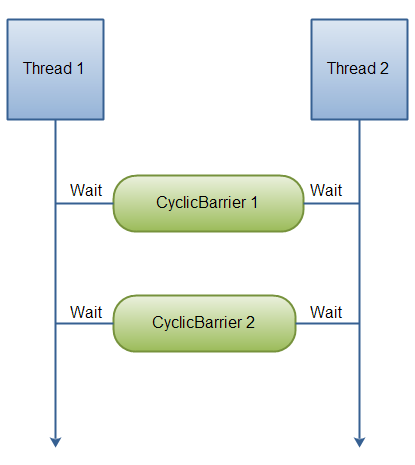CyclicBarrier
Jakob Jenkov |
The java.util.concurrent.CyclicBarrier class is a synchronization mechanism that can synchronize threads
progressing through some algorithm. In other words, it is a barrier that all threads must wait at, until all threads
reach it, before any of the threads can continue. Here is a diagram illustrating that:
 |
| Two threads waiting for each other at CyclicBarriers. |
The threads wait for each other by calling the await() method on the CyclicBarrier.
Once N threads are waiting at the CyclicBarrier, all threads are released and can continue running.
Creating a CyclicBarrier
When you create a CyclicBarrier you specify how many threads are to wait at it, before releasing them.
Here is how you create a CyclicBarrier:
CyclicBarrier barrier = new CyclicBarrier(2);
Waiting at a CyclicBarrier
Here is how a thread waits at a CyclicBarrier:
barrier.await();
You can also specify a timeout for the waiting thread. When the timeout has passed the thread
is also released, even if not all N threads are waiting at the CyclicBarrier.
Here is how you specify a timeout:
barrier.await(10, TimeUnit.SECONDS);
The waiting threads waits at the CyclicBarrier until either:
- The last thread arrives (calls await() )
- The thread is interrupted by another thread (another thread calls its interrupt() method)
- Another waiting thread is interrupted
- Another waiting thread times out while waiting at the
CyclicBarrier - The
CyclicBarrier.reset()method is called by some external thread.
CyclicBarrier Action
The CyclicBarrier supports a barrier action, which is a Runnable that is executed
once the last thread arrives. You pass the Runnable barrier action to the CyclicBarrier
in its constructor, like this:
Runnable barrierAction = ... ; CyclicBarrier barrier = new CyclicBarrier(2, barrierAction);
CyclicBarrier Example
Here is a code example that shows you how to use a CyclicBarrier:
Runnable barrier1Action = new Runnable() {
public void run() {
System.out.println("BarrierAction 1 executed ");
}
};
Runnable barrier2Action = new Runnable() {
public void run() {
System.out.println("BarrierAction 2 executed ");
}
};
CyclicBarrier barrier1 = new CyclicBarrier(2, barrier1Action);
CyclicBarrier barrier2 = new CyclicBarrier(2, barrier2Action);
CyclicBarrierRunnable barrierRunnable1 =
new CyclicBarrierRunnable(barrier1, barrier2);
CyclicBarrierRunnable barrierRunnable2 =
new CyclicBarrierRunnable(barrier1, barrier2);
new Thread(barrierRunnable1).start();
new Thread(barrierRunnable2).start();
Here is the CyclicBarrierRunnable class:
public class CyclicBarrierRunnable implements Runnable{
CyclicBarrier barrier1 = null;
CyclicBarrier barrier2 = null;
public CyclicBarrierRunnable(
CyclicBarrier barrier1,
CyclicBarrier barrier2) {
this.barrier1 = barrier1;
this.barrier2 = barrier2;
}
public void run() {
try {
Thread.sleep(1000);
System.out.println(Thread.currentThread().getName() +
" waiting at barrier 1");
this.barrier1.await();
Thread.sleep(1000);
System.out.println(Thread.currentThread().getName() +
" waiting at barrier 2");
this.barrier2.await();
System.out.println(Thread.currentThread().getName() +
" done!");
} catch (InterruptedException e) {
e.printStackTrace();
} catch (BrokenBarrierException e) {
e.printStackTrace();
}
}
}
Here is the console output for an execution of the above code. Note that the sequence in which
the threads gets to write to the console may vary from execution to execution. Sometimes
Thread-0 prints first, sometimes Thread-1 prints first etc.
Thread-0 waiting at barrier 1 Thread-1 waiting at barrier 1 BarrierAction 1 executed Thread-1 waiting at barrier 2 Thread-0 waiting at barrier 2 BarrierAction 2 executed Thread-0 done! Thread-1 done!
| Tweet | |
Jakob Jenkov | |











